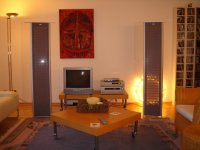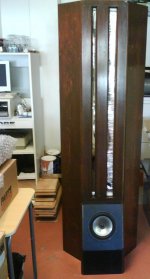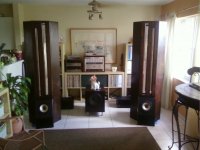Just wondering how to choose the correct size of ESL panel.
Option One - 1800MM * 300MM Panel for one ch.
Option Two - 2 1200MM*300MM Pancels for one ch.
If we use the same material,HV bias,spacer and step up transformer,is there a big difference of frequency response between both?
I just finished my first prototype and found it's much easier and cheaper to build the 1200MM*300MM panel.In fact,I am still looking for a big table to build the 1800MM*300MM panel.
Option One - 1800MM * 300MM Panel for one ch.
Option Two - 2 1200MM*300MM Pancels for one ch.
If we use the same material,HV bias,spacer and step up transformer,is there a big difference of frequency response between both?
I just finished my first prototype and found it's much easier and cheaper to build the 1200MM*300MM panel.In fact,I am still looking for a big table to build the 1800MM*300MM panel.
Hi,
just one panel, but make it less high and more wide, e.g. 1600x400
two panels just means increased building effort without any advantage against a single panel.
jauu
Calvin
Thanks for your suggestions.
If I connect two panels in parallel mode,how about the frequency response change? I am afraid that the bass response is not enough.
It's easier and cheaper to buy smaller stator sheet like 300MM*900MM.

Thanks.
Hi,
why shorter? Well, exactly I said shorter but wider. A panel of say 120cm height is alrady so high, that You can listen to it sitting as well as standing (if You want to mount it so). Such a panel will show it´s maximum SPL at a distance of 2.5-4m which is a common listening distance. A taller panel would show its maximum at greater distances.
The acoustic phase cancellation (apc) depends on the shortest dimension of the panel, which is the width. With a 30cm wide panel the apc will become effective below ~800Hz. Increasing panel width reduces the effect towards lower frequencies. So less equalization would be needed for a wider panel. Simply increasing width on the other hand would increase the panel´s area and so the capacitance and makes the panel a more difficult load to the amp. Above 1nF of capacitance transformer design becomes more difficult too. So to keep panel area and as such its capacitance below a certain value you trade height against width. ;-)
jauu
Calvin
ps: A FR-ESLs bass response will almost always not be ´enough´ if You ask for prime quality. But that´s my personal view ;-)
why shorter? Well, exactly I said shorter but wider. A panel of say 120cm height is alrady so high, that You can listen to it sitting as well as standing (if You want to mount it so). Such a panel will show it´s maximum SPL at a distance of 2.5-4m which is a common listening distance. A taller panel would show its maximum at greater distances.
The acoustic phase cancellation (apc) depends on the shortest dimension of the panel, which is the width. With a 30cm wide panel the apc will become effective below ~800Hz. Increasing panel width reduces the effect towards lower frequencies. So less equalization would be needed for a wider panel. Simply increasing width on the other hand would increase the panel´s area and so the capacitance and makes the panel a more difficult load to the amp. Above 1nF of capacitance transformer design becomes more difficult too. So to keep panel area and as such its capacitance below a certain value you trade height against width. ;-)
jauu
Calvin
ps: A FR-ESLs bass response will almost always not be ´enough´ if You ask for prime quality. But that´s my personal view ;-)
Hi,
i do not agree that any short panel is OK, depending on the listening distance.
There are some rumours saying panels get louder with increasing distance. I do not know, how this should happen. And nobody supported this statement by measurements.
I build more than 400 Pairs of ESL over the last 25 years and i can tell you, that any panel, independent from height lost sound pressure with increasing distance.
If you want most of the sound provided to your listening position without disturbance by room reflections ( and this is the main goal in typical living rooms) you should prefer cylindrical wave radiation. In best case you can achieve this radiation to lowest frequencies as possible and this is the reason why long panels easily outperform short panels.
E.G. a 180cm long panel will provide cylindrical radiation down to lower than 100 Hz.
Capaciti
i do not agree that any short panel is OK, depending on the listening distance.
There are some rumours saying panels get louder with increasing distance. I do not know, how this should happen. And nobody supported this statement by measurements.
I build more than 400 Pairs of ESL over the last 25 years and i can tell you, that any panel, independent from height lost sound pressure with increasing distance.
If you want most of the sound provided to your listening position without disturbance by room reflections ( and this is the main goal in typical living rooms) you should prefer cylindrical wave radiation. In best case you can achieve this radiation to lowest frequencies as possible and this is the reason why long panels easily outperform short panels.
E.G. a 180cm long panel will provide cylindrical radiation down to lower than 100 Hz.
Capaciti
Hi Chinsettawong,
basically yes !
Acoustat did it, Pütz did it, Quadfreaks stack their 57er three times......
There is a little compromise when stacking, since the arearless borders from one to the other panel will create the venetian blind effect, causing sound interferences, but this is limited to shorter linstening/measurement distances.
If stacking, borders at ear level height should be avoided (70 -110cm from floor)
Capaciti
basically yes !
Acoustat did it, Pütz did it, Quadfreaks stack their 57er three times......
There is a little compromise when stacking, since the arearless borders from one to the other panel will create the venetian blind effect, causing sound interferences, but this is limited to shorter linstening/measurement distances.
If stacking, borders at ear level height should be avoided (70 -110cm from floor)
Capaciti
Hello Calvin , Capaciti,
Thanks for explaining your positions on the above , both explanations seem reasonable and based on my experiences , Like Capaciti , I do prefer height over width, but this will require wings to archive any reasonable cut off below 400hz , Hence Calvin's comment on width. I have found it better to use wings for cut off than to have a wider panel vs height.
We also spent many hrs Last month , where a group of us have been comparing curved ESL to flat ESL and flat was better every time hands down, well at least in our setup and dedicated listening room.
regards,
Thanks for explaining your positions on the above , both explanations seem reasonable and based on my experiences , Like Capaciti , I do prefer height over width, but this will require wings to archive any reasonable cut off below 400hz , Hence Calvin's comment on width. I have found it better to use wings for cut off than to have a wider panel vs height.
We also spent many hrs Last month , where a group of us have been comparing curved ESL to flat ESL and flat was better every time hands down, well at least in our setup and dedicated listening room.
regards,
Last edited:
Hi Wayne,
your way is my favorite as well.
Make it as tall as possible, the width of membrane area should not exceed 20cm's, otherwise you will get trouble with mechanical stability, when uisng small D/S spacing.
Its better to add asymmetrical wings, lets say one third to two third width. Off axis interferences will be smoothed, resulting in better sound dispersion to the room.
Your overall bafflewidth should be at least 50cm. Than sound cancellation will start at 400 Hz, which is your crossover point.
Capaciti
your way is my favorite as well.
Make it as tall as possible, the width of membrane area should not exceed 20cm's, otherwise you will get trouble with mechanical stability, when uisng small D/S spacing.
Its better to add asymmetrical wings, lets say one third to two third width. Off axis interferences will be smoothed, resulting in better sound dispersion to the room.
Your overall bafflewidth should be at least 50cm. Than sound cancellation will start at 400 Hz, which is your crossover point.
Capaciti
Last edited:
Hi,
i have forgotten to mention:
Another advantage of a long panel is the fact that if its heigh enough, there is no need to tilt the panel back in order to focus the centre of height to ear level. Tilting back results in different frequency response depending on listening distance, since center height shifts.
And if you will have setup your ESL system, take the chance to listen to a chorus. I promise you, it will be the first time, that the singers do not need to fall on their knees when performing in your room ! They will stand upright in front of you
Capaciti
i have forgotten to mention:
Another advantage of a long panel is the fact that if its heigh enough, there is no need to tilt the panel back in order to focus the centre of height to ear level. Tilting back results in different frequency response depending on listening distance, since center height shifts.
And if you will have setup your ESL system, take the chance to listen to a chorus. I promise you, it will be the first time, that the singers do not need to fall on their knees when performing in your room ! They will stand upright in front of you
Capaciti
Hi,
just one panel, but make it less high and more wide, e.g. 1600x400
two panels just means increased building effort without any advantage against a single panel.
jauu
Calvin
1, Lower acoustic intermodulation distortion ?
2, Large single panels may struggle with HF.
Hi Chinsettawong,
basically yes !
Acoustat did it, Pütz did it, Quadfreaks stack their 57er three times......
There is a little compromise when stacking, since the arearless borders from one to the other panel will create the venetian blind effect, causing sound interferences, but this is limited to shorter linstening/measurement distances.
If stacking, borders at ear level height should be avoided (70 -110cm from floor)
Capaciti
I have another stators of 300MM*1800MM ready to use,but it needs more technique to finish the job.In fact,I do not find a table to fit the long stator.
If I could stack 2 stators to get the same performance,it's much easier to do.
Hi,
- active membrane area is always superior to passive winglets.
- tall thin panel´s SPL over distance increases first and begins then to fall off at distance. Measure such panels in 0.1, 1.0 and 4m distance and You´ll see.
If You can´t measure listen..it´s should be obvious.
- of course do panels of more than 20cm not become unstable. It´s just a matter of how to design the membrane supports. It might be a matter indeed with silcone dots as supports. If it were so, why do all large FR ESLs feature more width or paralleled multiple panels??
- a panel very tall and thin suffers from phase cancellation more than a less high but wider panel. You can´t use the ´additional´ height for much good, but the positive effect of less phase cancellation of a wider panel reduces EQuing needs immediately.
- wether flat or curved doesn´t matter that much, both principles have their special advantages and merits and the surroundings should be kept in mind (like transformer quality etc.). So I wouldn´t talk of better, because measuring my panels I´d like to see the panhead that comes close let alone beats them in their operating range. On the other hand Capaciti´s panels are truely remarkable pieces of flat art. So I´d rather talk of tastes.
On the other hand Capaciti´s panels are truely remarkable pieces of flat art. So I´d rather talk of tastes.
- there´s no obvious reason, why a 120cm tall panel has to be tilted. If I mount it in the right height (say with a socket of 60-70cm, below) it can be upright.
jauu
Calvin
- active membrane area is always superior to passive winglets.
- tall thin panel´s SPL over distance increases first and begins then to fall off at distance. Measure such panels in 0.1, 1.0 and 4m distance and You´ll see.
If You can´t measure listen..it´s should be obvious.
- of course do panels of more than 20cm not become unstable. It´s just a matter of how to design the membrane supports. It might be a matter indeed with silcone dots as supports. If it were so, why do all large FR ESLs feature more width or paralleled multiple panels??
- a panel very tall and thin suffers from phase cancellation more than a less high but wider panel. You can´t use the ´additional´ height for much good, but the positive effect of less phase cancellation of a wider panel reduces EQuing needs immediately.
- wether flat or curved doesn´t matter that much, both principles have their special advantages and merits and the surroundings should be kept in mind (like transformer quality etc.). So I wouldn´t talk of better, because measuring my panels I´d like to see the panhead that comes close let alone beats them in their operating range.
- there´s no obvious reason, why a 120cm tall panel has to be tilted. If I mount it in the right height (say with a socket of 60-70cm, below) it can be upright.
jauu
Calvin
Hi,
- active membrane area is always superior to passive winglets.
- tall thin panel´s SPL over distance increases first and begins then to fall off at distance. Measure such panels in 0.1, 1.0 and 4m distance and You´ll see.
If You can´t measure listen..it´s should be obvious.
- of course do panels of more than 20cm not become unstable. It´s just a matter of how to design the membrane supports. It might be a matter indeed with silcone dots as supports. If it were so, why do all large FR ESLs feature more width or paralleled multiple panels??
- a panel very tall and thin suffers from phase cancellation more than a less high but wider panel. You can´t use the ´additional´ height for much good, but the positive effect of less phase cancellation of a wider panel reduces EQuing needs immediately.
- wether flat or curved doesn´t matter that much, both principles have their special advantages and merits and the surroundings should be kept in mind (like transformer quality etc.). So I wouldn´t talk of better, because measuring my panels I´d like to see the panhead that comes close let alone beats them in their operating range.On the other hand Capaciti´s panels are truely remarkable pieces of flat art. So I´d rather talk of tastes.
- there´s no obvious reason, why a 120cm tall panel has to be tilted. If I mount it in the right height (say with a socket of 60-70cm, below) it can be upright.
jauu
Calvin
Hello Calvin ,
I would like to see the curvehead that beats flat
Measure all day , makes no difference , I'm with Capaciti in preferring flat panels over curved and wired stators with open grid over perf panels.
As to the OP , it is easier to work with 2 smaller panels than one big one , so i see no dis-advantage in doing so and 2 flat panels will work.
Ohhhh Seems like Sanders ( the original curved guy ) has come to the same conclusion and prefer's flat panels 2..........
YouTube - AudiogoN @ CES: Roger Sanders electrostatic loudspeakers
- Status
- This old topic is closed. If you want to reopen this topic, contact a moderator using the "Report Post" button.
- Home
- Loudspeakers
- Planars & Exotics
- 2 Small Panels or 1 Large One - ESL


